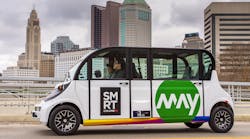Influencing electric vehicle (EV) adoption takes a multi-pronged approach. As the winner of the U.S. Department of Transportation’s US$50 million Smart City Challenge in 2016, Columbus was awarded $10 million from the Paul G. Allen Family Foundation to grow our region’s EV market in unprecedented ways. In 2015, only 0.38% of new cars purchased in the seven-county region were EVs. We set a goal to increase EV ownership by nearly 500% to 1.8% by 2020. Fortunately, we’re on pace to meet or surpass that goal, with EV sales exceeding 2% of vehicles sold at the end of 2018. To achieve this goal, Smart Columbus is partnering with the public and private sectors to make sure EV education, awareness, and adoption is prioritized. Here are some of the ways we’ve been able to move the needle in increasing EV adoption in the seven-county Columbus region.
Engaging Employers Through Programs and Incentives
Smart Columbus has partnered with more than 60 large employers in our seven-county region to achieve reduction of greenhouse gas emissions by accelerating EV adoption through workplace education and incentive programs.
Through our Acceleration Partner program, regional businesses engage with us to provide EV education, ride and drive events, and EV incentives to their employees. Participating businesses also commit to having an executive drive electric, consider EVs for their fleets, and install EV charging at major employment sites.
It is well understood that financial incentives move the EV market forward. In lieu of state purchase incentives, we established the Ignite Action Fund to provide match funding for our employer partners to introduce new financial incentives and benefits that motivate associates to drive electric and/or drive less. The purpose of the fund is to accelerate the timeline for launching new mobility benefits by reducing the initial cost-barrier. The long-term goal is to ensure these pilot benefit programs show value and are implemented at scale inside the organization without the need of matching funds.
For example, Alliance Data, a marketing services company, saw that Smart Columbus initiatives aligned with its commitment to sustainability and contributed to internal talent retention strategies. The company extended a US$1000 post-tax purchase incentive to all of their associates nationwide that purchased an EV in Q3 of 2018. The Ignite Action Fund was leveraged by Alliance Data to double the incentives to US$2000 post tax for EVs purchased to associates in the Columbus region. The program launched in late July 2018 and all 15 of the US$2000 rebates were claimed by mid-September by associates within the Columbus area.
American Electric Power (AEP) is a foundational partner of the Smart Columbus initiative and an electrification leader. Using the Ignite Action Fund, AEP Ohio executed an EV rebate program for employees of both AEP and AEP Ohio. The organization offered 15 US$2000 pre-tax rebates to employees within the region during Q4 of 2018. In less than 30 days, all rebates were awarded.
Ramping Up Workplace Charging
The presence of charging at the workplace follows model availability and public fast charging as one of the most important drivers of EV purchases. Since Smart Columbus’ inception, 44 work sites have installed 248 EV charging ports in the Columbus region. Smart Columbus works with facility and fleet teams of companies to select and install infrastructure to best meet their needs and support EV adoption among their associates. We help companies think through placement, the costs/benefits of different service providers, usage policies, and projected electricity usage costs.
Many of our companies with multiple worksites have been able to make a big impact by installing EV charging. One of our biggest champions in EV charging is Huntington, one of the nation’s largest banks that is headquartered in Columbus. The company installed Level 2 chargers at the Huntington Gateway Center, its newest facility that houses about 1600 employees, and at a suburban office. In 2019, Huntington plans to install chargers at their last major work site which is downtown, and at 40 to 60 local bank branches within the region.
Ride and Drive Roadshow
Our Ride and Drive Roadshow has exposed more people to EVs than any other program we offer. We work through our employer partners to bring an array of EVs to their corporate campuses, offering EV education and test drives to employees during the workday. This strategy is changing people’s minds about EVs. Since 2017, we’ve hosted 69 events and conducted nearly 8000 test drives through our program, with a goal to host 12,000 rides by 2020. 16.7% of test drivers asked to be contacted by a dealer for more information on an EV. Our pre- and post-drive survey found an increase in EV interest and affinity after test drives: the number of drivers who say they are likely or very likely to purchase an EV increased 16.7% after the drive. Post drive surveys also found that 50% more drivers said EVs are for them after their test drives.
In July 2018, we opened a test drive facility and technology show room at the Smart Columbus Experience Center in downtown Columbus and have welcomed more than 7000 visitors since its opening. More than 260 test drives have been conducted at the Experience Center, and residents and visitors around the globe are coming here to learn more about EVs and the transportation technologies of the future.
Empowering Dealers to Close the Sale
A report on battery-EVs published by Deloitte predicts that the cost of EV ownership will be equal to internal combustion engine vehicle sales by 2022, leading to an inevitable increase in sales. To offset the cost in the meantime, many states offer additional purchase incentives on top of the federal incentive. The state of Ohio neither offers tax incentives for zero-emission vehicles (the federal EV tax credit is still available) nor requires their sale through a ZEV or LEV policy. As such many original equipment manufacturers (OEMs) have not historically prioritized Ohio markets for distribution of their limited supply of these make and models. The lack of product inventory coupled with the above, resulted in a lack of sales experience by local dealers, which collectively impacted customers’ lack of options and little to no support when going to purchase a vehicle.
We created the Electrified Dealer program, a framework for local dealerships to get involved in increasing the product supply and receive training on EVs, including charging infrastructure and marketing, to help them close the sale with EV shoppers. As of April 2019, we have 25 certified electrified dealers. We ask dealers to increase their EV inventory and add chargers to show customers how to use them. We offer EV education workshops to their staff twice a year. While promoting Smart Columbus, we also give dealers an opportunity to co-brand EV-specific web and television commercials and content. In return, we send them leads from our Ride and Drive and Experience Center test drives.
A Model to Replicate
Reflecting on winning the U.S. Smart Cities Challenge, we won to demonstrate significant growth in a short amount of time and to see if localized adoption efforts could accelerate market results with the improved/improving product lines that exists today. We are proving this through the number of cities we are engaging with at conferences, through learning exchanges and online through the Smart Columbus Playbook. Our goal is to share as many lessons learned as possible to make it easy for another city or region to deploy these initiatives that we’ve tested and proven out. So far, we’ve had 41 learning exchanges with cities across the country and around the world, and more than 100 documents published to our playbook that are downloadable and reusable to inform other cities and regions as they consider creating smart mobility solutions.


